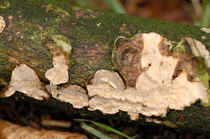 PB James Lindsey at Ecology of Commanster
PB James Lindsey at Ecology of Commanster Background on P. chrysosporium
Like other white-rot fungi, P. chrysosporium is a basidiomycete fungi which produces a number of complex extracellular enzymes that breakdown lignin. In nature, the white-rot fungi are one of the primary decomposers of wood. What is most interesting for waste treatment is the ability of the lignin peroxidase and glyoxal oxidase to act on other pollutants (non-specific enzyme activity).
Early test involved using white-rot fungi to decolorize pulp mill effluent where lignin creates highly colored water. In doing bench tests, researchers found the fungal enzymes also dechlorinated some of the halogenated organics found in chlorine bleached pulp wastewater. This started a whole new area of research into using white-rot fungi to bioremediate such compounds as:
- DDT & Lindane
- PCP (Pentachlorophenol) & Creosote - wood preserving wastes
- PCBs (Polychlorinated biphenyls)
- Dioxins
Revisiting the use of white-rot
With increased focus on decoloriziation and degrading many trace pharmaceutical products in wastewater, it may be time to reevaluate white-rot. Since target waste treatment is via a cometabolic pathway, we can use a relative inert carrier to hold/feed the white-rot cultures. The enzymes produced by the white-rot organisms can then cometabolize many of the problem trace xenobiotics.
Key items for research are:
- Finding an ideal immobilizing matrix for the fungi - alternative to wood chips
- Discover ways to optimize extracelluar enzyme production through carrier, nutrient, or environmental changes
- Evaluate how to put a biofilter with white-rot fungi to polish biologically treated waters to remove trae compounds

 RSS Feed
RSS Feed